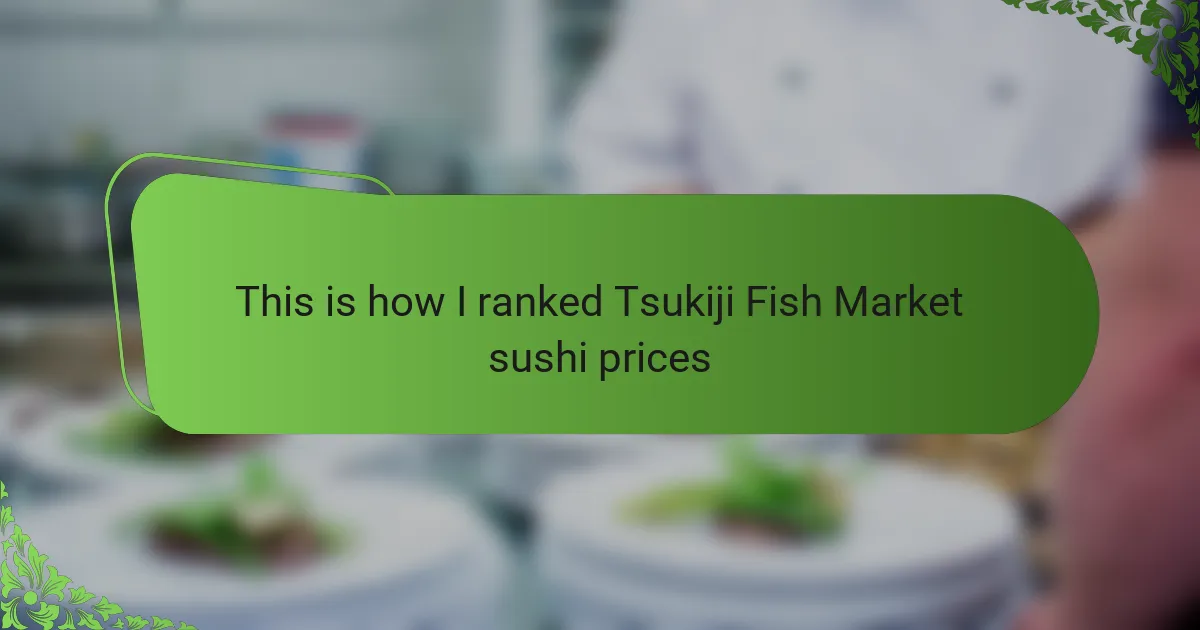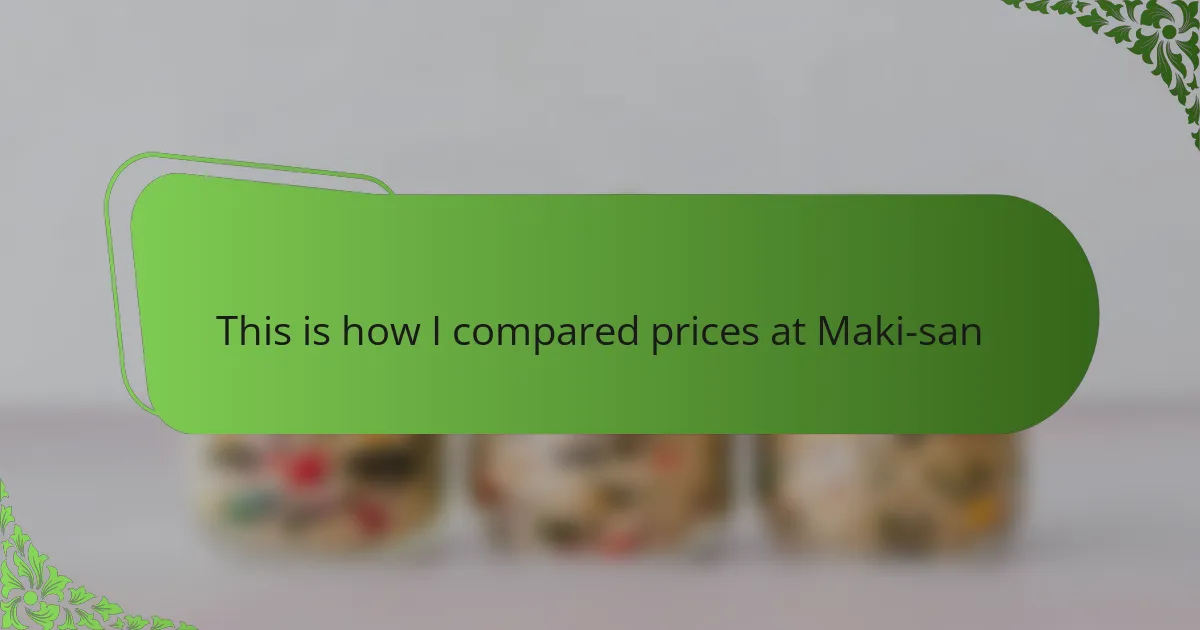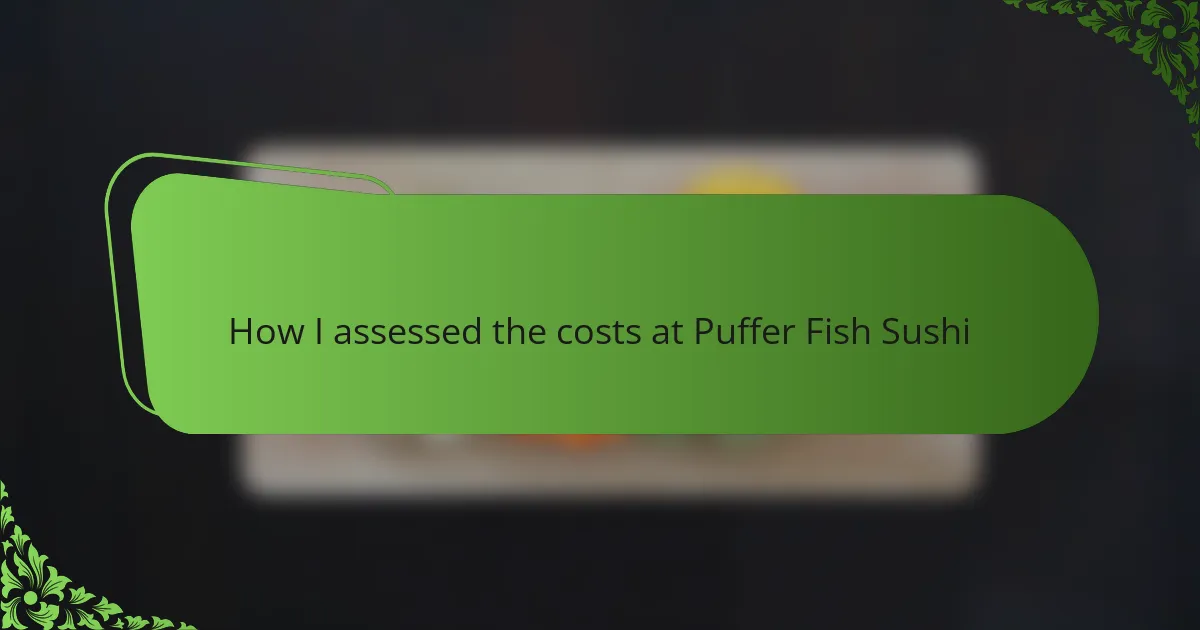Key takeaways
- Sushi reviews emphasize the importance of freshness, atmosphere, and service, influencing dining experiences significantly.
- Tsukiji Fish Market is renowned for its fresh fish and authentic sushi offerings, which reflect Japanese culinary artistry.
- Price variations in sushi stem from factors like seasonality, chef expertise, and market location, with a focus on authenticity and quality.
- For affordable sushi at Tsukiji, visiting early, engaging with vendors for recommendations, and trying pieces from multiple stalls can enhance the experience.
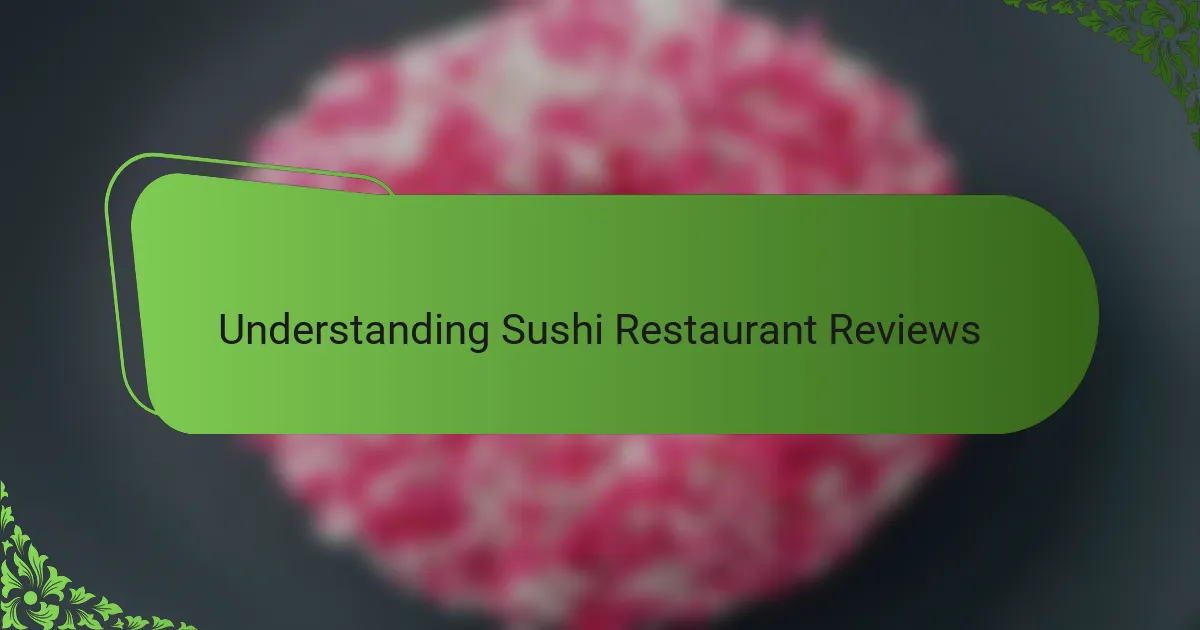
Understanding sushi restaurant reviews
When I first started reading sushi restaurant reviews, I realized they’re more than just ratings—they tell a story about the dining experience. Have you ever noticed how a simple mention of the fish’s freshness or the chef’s technique can sway your expectations? It’s these subtle details that help me decide if a spot is worth visiting.
What really resonates with me is when reviews describe the atmosphere and service, not just the food. A place might serve amazing sushi, but if the vibe feels rushed or cold, my experience isn’t complete. Don’t you find that the way staff interact can make or break a meal?
Sometimes, I think about how subjective sushi reviews can be. What I treasure in a sushi restaurant might differ from someone else’s priorities—like priciness or portion size. This diversity in perspective is why I read multiple reviews before making a judgment, searching for common threads that signal true quality.
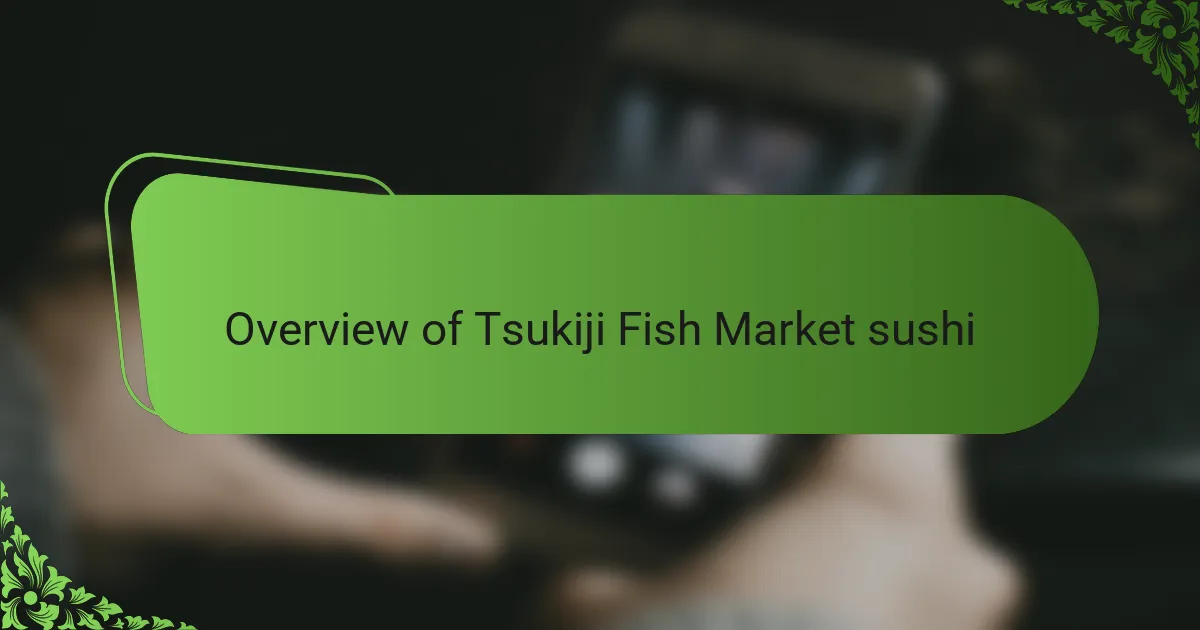
Overview of Tsukiji Fish Market sushi
Tsukiji Fish Market sushi has a reputation that precedes itself. From my visits, what stands out most is the incredible freshness of the fish — you can almost taste the ocean in every bite. Isn’t it amazing how something so simple can elevate sushi to an unforgettable experience?
What strikes me further at Tsukiji is the variety you find in sushi offerings. Whether it’s standard tuna or something more adventurous like uni (sea urchin), the quality tends to be consistent across the board. Have you ever wondered how this level of freshness is maintained daily? It’s a testament to the market’s dedication and expertise.
I also appreciate the authenticity that comes with sushi here. Compared to many restaurants that sometimes over-embellish presentations, Tsukiji sushi feels genuine and pure. That simplicity, combined with masterful preparation, often leaves me reflecting on why sushi is such an art form in Japan.

Factors influencing sushi prices
When I first started paying attention to sushi prices at Tsukiji, I noticed how seasonality plays a crucial role. Certain fish, like bluefin tuna, fluctuate wildly in price depending on the time of year and availability. Doesn’t it make you think twice about ordering your favorite nigiri when the market’s supply isn’t stable?
Another factor that caught my eye is the skill level of the sushi chefs. I’ve found that places with more experienced chefs tend to have higher prices, which makes sense because their precision and technique turn even simple ingredients into memorable bites. Have you ever considered how much effort goes into slicing and seasoning each piece perfectly before you even taste it?
Location also influences pricing more than we might expect. Tsukiji’s proximity to the source means fresher fish but also higher rents and operational costs that restaurants pass on to customers. When you think about it, paying a bit more here feels like an investment in authenticity and quality—doesn’t it?

Comparing sushi prices at Tsukiji
One thing I quickly realized when comparing sushi prices at Tsukiji is just how varied they can be, even within the same market. I once ordered two similar tuna nigiri from different stalls and was surprised by a noticeable price gap—it made me wonder if I was paying for freshness, reputation, or just the chef’s finesse. Have you ever experienced that moment where a small price difference sparks a big question about value?
I also took the time to note how portion sizes and presentation seemed to impact the cost. Some places served slightly larger cuts or added a touch of garnish that, to me, made the sushi feel more luxurious—and understandably justified the higher price tag. It got me thinking about how much these subtle differences contribute to the overall experience, beyond just the raw taste.
What really stood out was how transparent many vendors were about pricing. Unlike restaurants where menus can feel like a guessing game, Tsukiji’s stalls often display prices clearly, which helped me make quick decisions without second-guessing. That straightforwardness made the whole comparison easier and made me appreciate the honesty in this bustling market.

Personal ranking methodology explained
When I decided to rank Tsukiji’s sushi prices, I knew I had to go beyond just jotting down numbers. I spent time tasting similar items from different vendors, noting not only price but also size, freshness, and the atmosphere around the stall. Have you ever found yourself wondering if a shinier piece of fish or a chef’s quick smile makes that extra yen worth it? For me, those little moments are part of what shapes value.
I also considered how transparent each vendor was about their prices. Some stalls proudly posted their rates, making it easy to compare, while others left me guessing, which definitely affected my perception of fairness. Does a clear menu make you trust a place more? In my experience, it does—knowing what you’re paying for feels like a mark of respect.
Finally, I reflected on how the subtle touches—like presentation or the chef’s skillful handling—added intangible value that no price tag can fully reveal. Even if two nigiri cost the same, the experience can feel worlds apart. This made me realize that my ranking isn’t just about cost; it’s about the story behind each bite. Wouldn’t you agree that sushi is as much about feeling as it is about flavor?
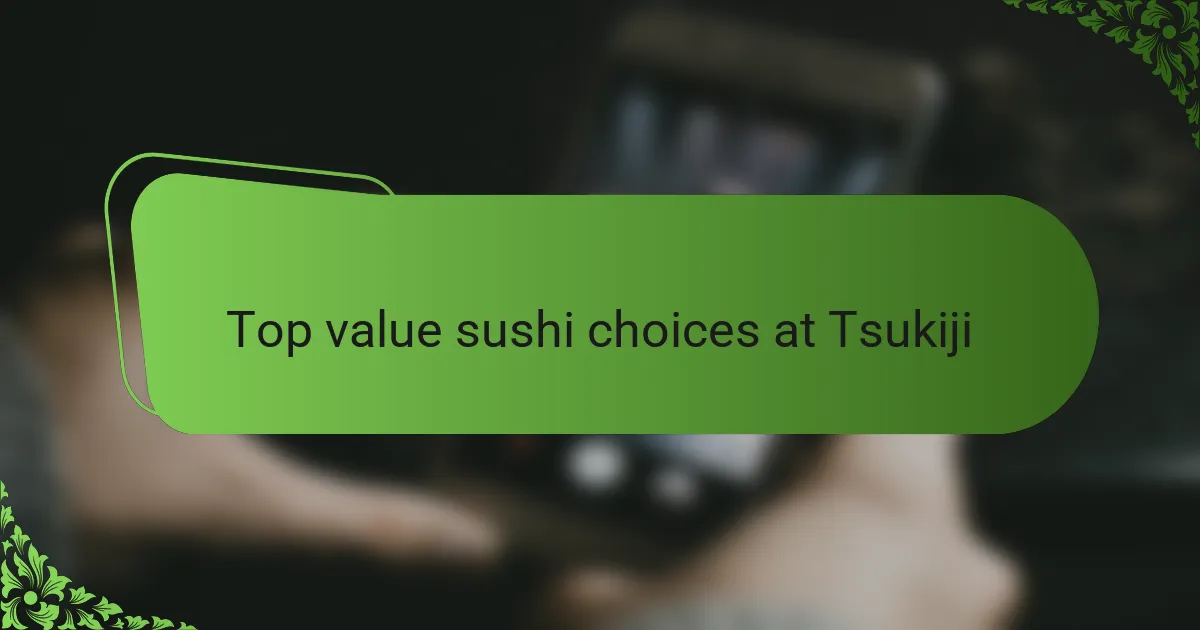
Top value sushi choices at Tsukiji
When I look for top value sushi at Tsukiji, I always zero in on pieces like akadashi (lean tuna) and saba (mackerel). These cuts often deliver incredible flavor and freshness without the premium price tag of bluefin tuna. Have you ever been pleasantly surprised by a simple nigiri that tastes better than something more expensive? That’s exactly the kind of value I seek here.
Uni, or sea urchin, caught my attention as well—not because it’s cheap, but because the quality at Tsukiji makes the price feel justified. On a few occasions, I’ve splurged on uni that melted in my mouth with a delicate sweetness that cheaper versions just can’t match. Isn’t it fascinating how freshness can transform the experience so completely?
What really stays with me is how some stalls manage to strike a balance between price and taste by offering seasonal specialties. For example, a vendor once recommended their pick of the day—an unexpected catch that was surprisingly affordable but tasted remarkable. Moments like that remind me why exploring Tsukiji’s value sushi is always an adventurous delight.

Tips for affordable sushi at Tsukiji
If I had to share one tip for affordable sushi at Tsukiji, it would be to arrive early—really early. From my experience, catching the market just as it opens means you get first dibs on the freshest, best-priced fish before the crowds push prices higher. Have you ever noticed how those morning hours bring out the most lively, bustling vibe? It’s like being part of a secret club where the best deals quietly happen.
Another trick I’ve learned is to chat with the vendors. I often ask them what’s freshest and budget-friendly that day. Their recommendations feel more genuine than menu descriptions, and sometimes they even suggest off-menu specials that don’t carry a premium price. Don’t you think it’s more fun to order based on insider tips rather than just picking from the list?
Lastly, pacing yourself makes a big difference. Instead of ordering a big platter all at once, I try different stalls for just a piece or two each. That way, I get to savor variety without blowing my budget. Have you ever found that hopping around keeps not only your wallet but also your palate happy? It’s a small strategy that really changed how I enjoy Tsukiji sushi.
